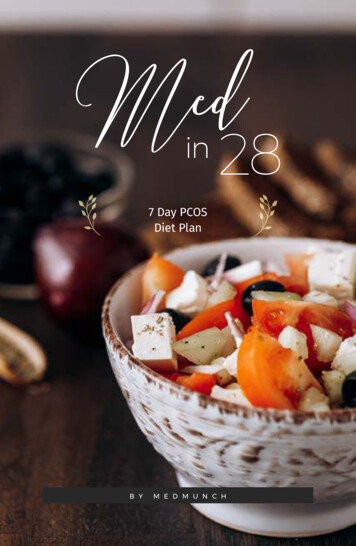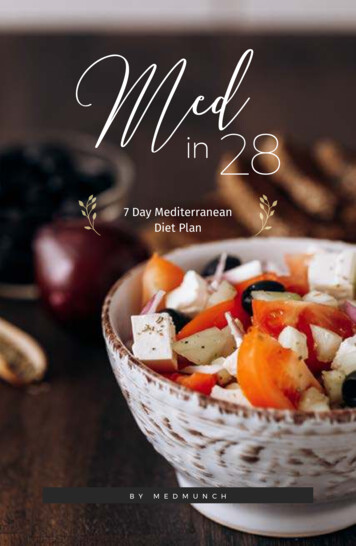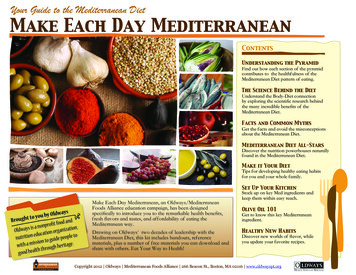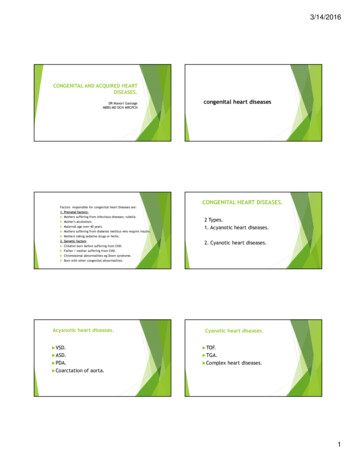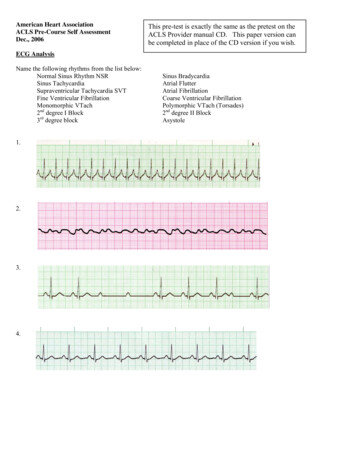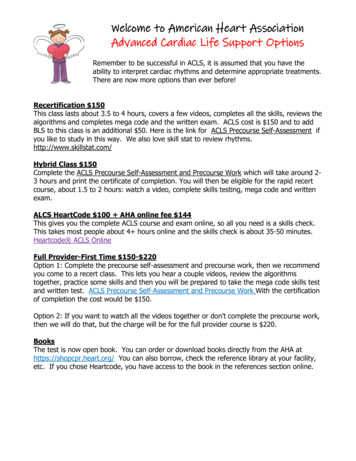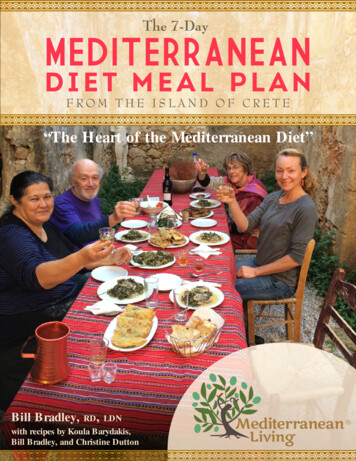
Transcription
“The Heart of the Mediterranean Diet”Bill Bradley, rd, ldnwith recipes by Koula Barydakis,Bill Bradley, and Christine Dutton
EE
The 7-DayMediterraneanDiet Meal Planfrom the Island of CreteQ u i ck - l o o kBreakfasts.8Hard Boiled Eggs with Whole Grain Sourdough Bread and Extra Virgin Olive OilGreek Yogurt with Fruit, Nuts, Cinnamon, and HoneyFruit and NutsEggs and Tomatoes, the Cretan WayCrunchy Greek SaladLeftovers from any mealLunches and DinnersEgg Noodles with Walnuts and Basil.10Leeks and Celery.10Halibut with Rosemary.11Cucumber, Carrot, and Beet Salad.11Stuffed Tomatoes and Peppers.12Beef with Eggplant and Herbs.13Spinach with Lemon.13Cretan Salad.14Black-Eyed Beans with Herbs.15Lentil Soup.16Snacks and Desserts.8Handful of NutsFruitFeta or Goat Cheese with Whole Grain Sourdough BreadWhole Grain Sourdough Bread with Extra Virgin Olive OilTzatziki with Whole Grain Sourdough Bread3 Bonus MealsGreen Beans with Lean Pork or Chicken.17White Bean Soup.18Salmon with Yogurt, Spinach, Lemon and Capers.19Bonus RecipePatata Salata.20
About billBill has been teaching and writing about Mediterranean Diet and Lifestyle for the past 10 years. Recently, Bill spent time on theMediterranean island of Crete researching the traditional cuisine and co-writing “Foods of Crete, Traditional Recipes from the HealthiestPeople in the World.”Bill has led over 1600 talks and cooking workshops; has been featured on ABC News on-line, various newspapers, magazines, and talkshows; and has authored 2 cookbooks. Recently, Bill and Gerry LeBlanc created two 10 week on-line challenge based wellness programsincluding one on “How to Eat and Live Mediterranean” which has had thousands of participants reporting that the programs helpedthem to make significant changes in their lives.Bill’s passion is to live and teach the principles of good food, generosity, and how to open our hearts while we take care of ourselves andothers. Bill shares a love of travel and adventure with his wife, Christine Kenneally.My StoryThe Mediterranean way of living has changed my life. I was brought up on a typical American diet ofsugary, processed, frozen, often microwaved or boiled foods. As a kid, I learned dieting behaviors frommy mom, who struggled with weight problems her entire life. I was often dragged to Weight Watchers andOvereaters Anonymous meetings. I tried the first version of Weight Watchers ice cream and I rememberbeing disgusted by the gummy, fake taste. There were times when our house was filled with “diet” foods,and other times when it was overloaded with Nutter Butter cookies and Fluff. In my pre-teen years Ilearned how to “stuff my emotions” by overeating. Suddenly, I, too was overweight and struggling.Over the years I tried different ways to lose weight. This always led to me gaining more weight. Because of my struggles with weightloss, I decided to become a dietitian. I wanted to help others lose weight. But, by the time I had received my dietetic license, I had gainedanother 30 pounds!A few years after becoming a dietitian, I was hired into a groundbreaking program at Noble Hospital in Westfield, Massachusetts. It wasa one-year lifestyle modification program for patients with heart disease. Participants met for 3½ hours once a week, during which timethey consulted with a doctor, took part in a support group, exercised, did a Tai Chi class, and cooked a Mediterranean meal. Participantsmade very significant and lasting lifestyle changes resulting in lower heart attack risk.As I researched the Mediterranean diet and lifestyle, I began to think of how and what I ate in a very different way. At this point myunderstanding of the diet was only from reading and research. Even though I was lecturing about the benefits of the Mediterranean dietand teaching many Mediterranean cooking classes, I hadn’t yet experienced the Mediterranean diet and lifestyle firsthand.
The Island of CreteI decided to enrich my understanding of the Mediterranean diet by living on the Greek island of Crete. I chose Crete because of itsincredibly high longevity and low morbidity rates. In the 1960’s, Crete had the highest longevity rates in the world, and men there lived tobe the same age as women. I mention these studies and several more below.While living in Crete, I interviewed villagers and chefs, collecting recipes and experiencing firsthand how the people of the island eat andlive. I was fortunate enough to meet Koula Barydakis, a chef from the island, who shared with me over 125 of her family’s recipes. Thesewere exactly the recipes I had been working so hard to find—the traditional recipes from a time when the diet in Crete was considered thehealthiest in the world. These recipes became the cookbook “Foods of Crete: Traditional Recipes from the Healthiest People in the World”,which I co-wrote with Koula. The recipes in the 7-day meal plan below are mostly Koula’s from the cookbook.I took away many important lessons from my time on the Island of Crete. First and foremost, I began the process of giving up dieting. Ittook me a while, because the practice of dieting was so ingrained in me. But as I switched my focus to eating well, moving my body, andtaking care of my emotions and stress in creative and healthy ways (besides eating), I have steadily lost weight. I have begun to celebratefood and eating instead of considering it my “frenemy”. There are certainly days when I eat decidedly “un-Mediterranean”, but now thetimes I slip back into my old unhealthy habits are few and far between.On top of being able to truly enjoy eating again, the Mediterranean lifestyle of slowing down, not taking everything so seriously, andtaking time to enjoy life has made me a happier, more centered person. The Mediterranean way is about coming back to your healthy selfby eating and living well. I hope it helps to change your life the way it has changed mine.I hope you find this e-book helpful. We love to hear from our community (that’s you!) about your experiences incorporating theMediterranean diet and lifestyle into your life.Bill Bradley, R.D., L.D.N.President, Mediterranean Living
The Diet of Crete“Heart of the Mediterranean Diet”To discover how people in Crete ate over 60 years ago (when they were truly considered the healthiest people in the world), I traveled toremote villages in the mountains of the island. I learned that their traditional foods were simple (usually cooked over a fire), full of flavor(utilizing lots of fresh herbs and olive oil), and made from ingredients that can be easily obtained in the U.S. Here are some of the thingsI learned:The food was mostly unprocessed: There were no packaged convenience foods on the island. Everything was made from scratch.The vast majority of processed foods in stores today are full of inflammatory ingredients such as sugars, heavily processed flour, andchemicals.They ate a high fat diet: Over the last 40 years we have heard the mantra that fat is bad for us. It has become so ingrained in our culturethat it is very difficult to think otherwise. On the island of Crete, they traditionally ate 40% of their daily calories from fat. 30% of thatwas from fresh extra virgin olive oil. Extra virgin olive oil with a peppery burn is a strong anti-inflammatory and will help decrease your“bad” LDL cholesterol. It will also help you lose weight if combined with a Mediterranean diet.They ate a mostly organic, plant-based diet: The average American eats about 2½ servings of fruits and vegetables per day. Theaverage person in Crete traditionally ate at least 9 servings of fruits and vegetables per day.Their main protein source was beans: Americans get the majority of their protein from meat and chicken. In Crete and Greece andthe rest of the Mediterranean, the main protein source is beans. Beans have been shown to decrease the risk of heart disease, diabetes,and colorectal cancer.
They ate lots of foods with omega-3 fats: It has been hypothesized that one of the reasons that Greeks and the inhabitants ofCrete are so healthy is because of the large amounts of omega-3 fats they get in their diet. Where do all the omegas come from?First, they eat greens packed with omega-3’s, such as dandelion and mustard greens. They also eat grass-fed meat, chicken, andeggs, as well as ocean-raised fish, and nuts such as walnuts and almonds, all of which are high in omega-3 fats.They drank wine and ate bread and cheese: In Crete, wine is consumed in small amounts every day, sometimes with bothlunch and dinner. Red wine may decrease the risk of heart disease by increasing HDL (good) cholesterol and protecting thearteries in the heart. The inhabitants of Crete also eat whole grain sourdough bread daily (sourdough has a slower effect on bloodsugar than yeast bread) and naturally low-fat cheese (feta and goat) in small amounts.The Rockefeller Foundation’s Studies on the Mediterranean Diet in CreteThe first studies on the Mediterranean diet were done on the Greek island of Crete just after World War II. Initially, the RockefellerFoundation was asked by the Greek government to help Crete because of its abject poverty and the destruction of the island thattook place during the war. The Rockefeller Foundation sent many different “field staff” to the island, including nutritionists.Student nurses visited 1 out of every 150 homes, where they took notes on all food and drink consumed during a two weekperiod. To the total surprise of the researchers, the inhabitants of Crete ate a low protein, high fat diet (mostly olive oil), and were“living well” into old age. The other surprise was that they could find almost no heart disease among a population that was eating40% of their daily calories from fat.Ancel Keys’ 7 Country Study, and Heart Disease in CreteIn the late 1950’s, a large research project led by the American scientist Ancel Keys looked at heart disease in men from aroundthe world and found some truly incredible results. At the time of the study, the heart disease rate for men in the United Stateswas 92 men per 1,000, while on the island of Crete it was 3 men per 1,000. As a matter of fact, when the researchers first went toCrete, they could only find one man who had suffered any type of heart disease in the previous ten years!Recent Mediterranean Diet StudiesSince these first studies appeared there have been literally thousands of studies that show the health benefits of the MediterraneanDiet. Some of the latest studies show that people who eat Mediterranean have a decrease in diabetes risk even if they don’t loseweight, as well as a decreased risk of dementia and Alzheimer’s.
How to use the recipes:The recipes for the 7-day meal plan were chosen to represent atypical week on the Mediterranean island of Crete. You shouldbe able to find all the ingredients in most supermarkets.Olive Oil: You will notice that some of the recipes call for upto a cup of extra virgin olive oil. When I was researching onthe island I found some recipes with up to two cups of oliveoil. Yet the inhabitants had the lowest rates of heart diseasein the world! A diet high in the right types of fats is not onlydelicious, but healthy! I recommend trying the recipes andseeing how you feel. Since most of what you will be eating onthe Mediterranean diet is low calorie vegetables, and becausehealthy fats help you feel full, you will probably find yourselfeating less and losing weight.Chamomile Tea – Decreases anxiety, reduces inflammation,and may help to fight off cancer.Oregano Tea - Helps with digestion, especially after heavymeals.Wine: The inhabitants of Crete are famous for theirconsumption of red wine and a moonshine drink called “Raki”.Wine is consumed every day, usually with lunch and dinner. Itis almost always consumed with food. As with most everythingelse, the wine is organic and local. It also has none of thesulfites and additives that are in most wines bought in stores.Any type of alcohol will increase your “good” HDL cholesterol,but there is a substance in red wine (Resveratrol) that may alsohelp decrease the “bad” LDL and reduce blood clots. Obviously,if you have any issues with alcohol, then we don’t recommendyou start drinking. If you do like wine, then you should drink itin small amounts (no more than a glass or two) with a meal.Calories: There is no calorie counting in the Mediterranean.The Mediterranean way is about celebrating food, family andcommunity. Counting calories is a large part of what has mademany of us in the U.S. “crazy” around food. Giving it up returnsus to truly enjoying what we eat. For these reasons there are nocalories listed for the recipes.Desserts: The dessert of choice in Crete is fresh fruit.Occasionally there is baklava (a very small amount) or a cookie(made with extra virgin olive oil), but the majority of the timeit’s an apple, orange, or grapefruit.Breakfast: The breakfast suggestions we have included followthe basic guidelines of eating Mediterranean and are quickand simple for the person on the run. Most of the breakfastideas are so simple that we don’t give specific recipes. Whatyou want to stay away from is highly processed foods such assugary cereals, bagels, doughnuts, and heavily sweetened (andfattened) coffee drinks.Salads: Salads are eaten often on the Island of Crete either asa main meal, side dish, or a snack. Feel free to add or substitutea salad for any of the meals in the 7-Day Mediterranean DietMeal P7lan. Below is my take on a traditional Greek salad, anda few of my favorite dressings which you can use on a simplesalad. These dressings are very flavorful. Consider adding themto your repertoire and use instead of store bought dressings.Coffee: Coffee is enjoyed throughout the Mediterranean. Formost, coffee is a healthy drink as long as lots of sugar andprocessed creams are not added.Crunchy Greek SaladThere is a long history in Crete of medicinal teas, which are usedfor everything from digestion to mental clarity, as well as theirantimicrobial and antiviral properties.2 large carrots, cut into small pieces1/2 red onion, thinly sliced1 red pepper, cut into bite-sized pieces1 large cucumber, peeled and sliced1 tomato, cut into bite-sized pieces3-4 sprigs parsley, stems removed1/2 cup pitted Kalamata olives1/2 cup olive oilJuice of 1 lemon4 ounces feta cheeseSalt and pepper, to tasteHere are a few examples of teas that are enjoyed in theMediterranean:1. Mix all vegetables in a bowl with olive oil and lemon juice.2. Top with crumbled feta cheese. Toss with salad.Herbal Teas: Mountain Teas: One time while I was in CreteI caught a cold. I wanted to get some kind of cold medicineso I headed down to the local market. When I told the clerkmy symptoms he pulled a bag of dried herbs from under thecounter and told me to make a tea out of it. It turned out tobe an herb called “diktamos”. I made the tea, went to bed, andwoke up the next morning feeling much better.Mint Tea - Helps with digestion, coughs, and bad breath. Minttea may also help with mental clarity and relaxation.Green Tea - Packed with antioxidants, green tea has beenshown to decrease the risk of congestive heart failure, lowerblood pressure, and stabilize blood sugar levels in diabetics.Potentially helpful in reducing cancer cell growth, reducing therisk of Alzheimer’s, and increasing brain function.Serves 4 as main dish saladServes 6 as side saladRecipe by Bill Bradley, R.D.
Dressings:Dijon Balsamic VinaigretteLemon Parmesan Dressing1 cup extra virgin olive oil1/3 cup balsamic vinegar1 tablespoon Dijon mustard2 tablespoons honey1/4 teaspoon oreganoSalt and pepper, to taste1/4 cup lemon juice1 cup extra virgin olive oil1/2 cup grated parmesan cheese2 teaspoons Dijon mustard1 teaspoon dried dill2 cloves garlic, pressed through garlic pressSalt and pepper, to taste1. Mix all ingredients in a bowl and whisk for about 2 minutesuntil mixture begins to thicken.2. Pour dressing into a jar. Refrigerate for at least 1 hour beforeserving.1. Mix all ingredients in a bowl and whisk for about 2 minutesuntil mixture begins to thicken.2. Pour dressing into a jar. Refrigerate for at least 1 hour beforeserving.Recipe by Bill Bradley, R.D.Recipe by Bill Bradley, R.D.Lunch and DinnerIn Crete, the same meal is usually eaten both at lunch and dinner. My suggestion is to cook a recipe for dinner and then have theleftovers for lunch the next day.If, when you look through the recipes, you see something that doesn’t appeal to you, I recommend two possibilities: 1) Give it a tryanyway. Recipes from Crete are quite different than what you are probably used to. You might find you like what you think you won’t!2) Feel free to substitute. We have given you recipes for 3 extra meals. You can substitute these for meals on the plan if you like. Or, ifthere is a recipe you really enjoyed, you can always make it again!
Egg Noodles with Walnuts and BasilPhoto by Christine DuttonMeal OneEgg Noodles with Walnuts and BasilLeeks and CeleryEgg Noodles with Walnuts and BasilLeeks and Celery1 pound egg noodles, dry4 tablespoons extra virgin olive oil1 onion, grated1 cup white wine1 clove garlic, chopped1 pound fresh tomatoes, cubed1 cup walnuts, chopped2 tablespoons fresh basil, chopped (or 1 teaspoon dried)Salt and pepper, to taste1 teaspoon sugar1 teaspoon tomato paste1/2 cup extra virgin olive oil1 pound celery, thinly1 pound leeks (white part only), cut into thin rounds1 large onion, chopped1 cup grated tomatoes1½ cups waterSalt and pepper, to tasteNutmeg1. Sauté onions in 2 tablespoons oil for 5 minutes.2. Add the wine, garlic, and tomatoes. Simmer for 15 minutes.3. Add the walnuts, basil, salt, pepper, sugar, and tomato paste.Simmer for 10 minutes or until thick.4. Cook egg noodles according to directions on package. Strainnoodles and add 2 tablespoons of olive oil. Add sauce and toss.Serve with freshly grated parmesan cheese.1. Sauté celery and leeks in olive oil for 5 minutes.2. Add the onion and tomatoes. Sauté for 5 minutes more.3. Add water and simmer for 30 minutes. Add salt and pepper totaste.4. Once finished, sprinkle (very lightly) with nutmeg.Serves 8Recipe by Koula BarydakisFrom the book “Foods of Crete: Traditional Recipes from the HealthiestPeople in the World”Serves 6Recipe by Koula BarydakisFrom the book “Foods of Crete: Traditional Recipes from the HealthiestPeople in the World”10MediterraneanLiving.com The 7-Day Mediterranean Diet Meal Plan facebook.com/MediterraneanLiving
Cucumber, Carrot, and Beet SaladPhoto by Christine DuttonMeal TwoHalibut with RosemaryCucumber, Carrot, and Beet SaladHalibut with RosemaryCucumber, Carrot, and Beet Salad4 6-ounce halibut steaks2 onions, chopped2 cloves garlic, mashed1/2 cup extra virgin olive oil3 fresh tomatoes, cubed small1/2 cup fresh lemon juice2 tablespoons rosemary, fresh or driedSalt and pepper, to taste1 tablespoon mustard1 cucumber, sliced into rounds1 carrot, grated1 small or 1/2 large beet, gratedHandful of dark green lettuce1/4 cup Dijon vinaigrette (recipe on page xx)1. Preheat oven to 350 degrees F.2. Sauté the onions and garlic in olive oil for 5 minutes.3. Add the tomatoes, lemon juice, rosemary, mustard, salt, andpepper. Sauté for 5 minutes.4. Place the halibut steaks in one layer on a lightly oiled bakingdish. Cover with rosemary mixture.5. Cover baking dish with foil and bake for 30 minutes.Recipe by Bill Bradley, R.D.1. In a salad bowl, add all veggies and toss with vinaigrette.Serves 2Serves 4Recipe by Koula Barydakis.From the book “Foods of Crete: Traditional Recipes from the HealthiestPeople in the World”11MediterraneanLiving.com The 7-Day Mediterranean Diet Meal Plan facebook.com/MediterraneanLiving
Stuffed Tomatoes and PeppersPhoto by Christine DuttonMeal ThreeStuffed Tomatoes and Peppers5 tomatoes5 green or red peppers1 cup parsley, stems removed1 cup dill, stems removed2 large onions, cut into quarters1 cup water1 tablespoon tomato paste1 cup uncooked rice1/2 cup extra virgin olive oil1 teaspoon salt1/2 teaspoon pepperFor the sauce:1/2 cup extra virgin olive oil1 tablespoon tomato paste1 cup water1/2 teaspoon saltDash of pepper12Stuffed Tomatoes and Peppers1. Preheat oven to 350 degrees F.2. Wash the tomatoes. Slice the tops almost off but leave attachedto the tomato, creating a “hinge”. Scoop out the insides with aspoon, reserving pulp for stuffing.3. Wash the peppers, slice the tops almost off, but leave attached tothe pepper, creating a “hinge”. Remove and discard seeds.4. In a blender, add the insides of the tomatoes with the parsley,dill, onions, 1 cup water, and tomato paste. Blend for 2 minutes.5. Pour the blended mixture into a bowl. Add the rice, oil, salt, andpepper. Mix well with a spoon.5. Fill each tomato and pepper with the rice/vegetable mixture.Put in a casserole dish.6. For the sauce, mix the 1/2 cup olive oil, tomato paste, water,salt, and pepper. Cover the tomatoes and peppers with the sauce.7. Bake for 1 hour uncovered or until rice is done.Serves 5Recipe by Koula Barydakis.From the book “Foods of Crete: Traditional Recipes from the HealthiestPeople in the World”MediterraneanLiving.com The 7-Day Mediterranean Diet Meal Plan facebook.com/MediterraneanLiving
Beef with Eggplant and HerbsPhoto by Christine DuttonMeal FourBeef with Eggplant and HerbsSpinach with LemonServe with a saladBeef with Eggplant and HerbsSpinach with Lemon and Garlic2 pounds lean beef, cut into bite-sized cubes5 tablespoons extra virgin olive oil2 onions, chopped1 lb zucchini, sliced1 lb eggplant, cubed1 teaspoon dried thyme1 teaspoon dried sage2 tablespoons fresh mint, choppedSalt and pepper, to taste10-oz. bag fresh spinach2 tablespoons extra virgin olive oil2 cloves garlic, choppedJuice of 1/2 lemonSalt and pepper, to taste1. In a pot, heat half of the oil and brown the meat. Coverthe meat with water and simmer.2. In another pot, add the rest of the oil and sauté theonions and vegetables until soft, about 10 minutes.3. Stir in the tomatoes, then add the vegetable mixture tothe meat.4. Add the thyme, sage, and mint. Add salt and pepper totaste. Bring to a boil and simmer for 45 minutes.1. In a medium sized pot, sauté garlic in olive oil for 1minute.2. Add spinach and sauté until wilted.3. Add lemon juice, and salt and pepper to taste.Serves 2-4Recipe by Bill Bradley, R.D.Serves 6Recipe by Koula Barydakis.From the book “Foods of Crete: Traditional Recipes from theHealthiest People in the World”13MediterraneanLiving.com The 7-Day Mediterranean Diet Meal Plan facebook.com/MediterraneanLiving
Cretan SaladPhoto by Christine DuttonMeal FiveCretan SaladServe with whole grain breadCretan Salad2 or 3 zucchini, sliced into thin rounds4 potatoes, cut into cubes2 tomatoes, sliced2 cucumbers, peeled and sliced1 onion, sliced into thin rings1/2 cup pitted Greek olives1/2 cup lemon juice3 hard boiled eggs, sliced into quarters4 ounces of Greek feta, cubed1 teaspoon dried oreganoSalt and pepper, to taste141. Boil zucchini until soft. Rinse in cold water to cool, drain.2. Boil potatoes until soft. Rinse in cold water to cool, drain.3. Add all ingredients. Toss lightly. Season with salt and pepperto taste. Chill until ready to serve.Serves 4Recipe by Koula Barydakis.From the book “Foods of Crete: Traditional Recipes from theHealthiest People in the World”MediterraneanLiving.com The 7-Day Mediterranean Diet Meal Plan facebook.com/MediterraneanLiving
Black-Eyed Beans with HerbsPhoto by Bill BradleyMeal SixBlack-Eyed Beans with HerbsServe with a SaladBlack-Eyed Beans with Herbs2 large (29 oz) or 4 small (15 oz) cans black-eyed beans1/2 cup extra virgin olive oil1 cup fresh parsley, stems removed, chopped1 cup fresh dill, stems removed, chopped4 green onions, thinly sliced2 carrots, peeled and grated2 bay leaves2 slices orange with peel and flesh2 tablespoons tomato pasteSalt and pepper, to taste151. Drain beans, reserving liquid.2. Heat oil in a deep pot. Sauté beans, parsley, dill, onions, andcarrots for 3 minutes.3. Add bay leaves, orange peel, tomato paste, 2 cups reservedliquid from beans, and 1 cup water.4. Stir and cook for 30 minutes.5. Add salt and pepper to taste.Serves 6By Koula Barydakis and Bill Bradley, R.D.From the book “Foods of Crete: Traditional Recipes from theHealthiest People in the World”MediterraneanLiving.com The 7-Day Mediterranean Diet Meal Plan facebook.com/MediterraneanLiving
Lentil SoupPhoto by Christine DuttonMeal SevenLentil SoupServe with Feta Cheese and OlivesLentil Soupserve with Feta Cheese and Olives1 pound lentils, washed well, stones removed6 cups water1 cup extra virgin olive oil2 cloves garlic2 tablespoons tomato paste1 onion, grated3 carrots, grated1 slice orange, peel and flesh1 bay leafSalt and pepper, to taste161. In a deep pot, add lentils and 6 cups water. Bring to a boil andcontinue boiling for 15 minutes.2. Add remaining ingredients and continue cooking on a lowboil for 30 minutes or until lentils are soft. Add more water ifneeded.Serves 6Recipe by Koula Barydakis and Bill Bradley, R.D.From the book “Foods of Crete: Traditional Recipes from theHealthiest People in the World”MediterraneanLiving.com The 7-Day Mediterranean Diet Meal Plan facebook.com/MediterraneanLiving
Green Beans with Lean Pork or ChickenPhoto by Christine DuttonBONUSmeal oneGreen Beans with Lean Pork or ChickenServe with a Greek Salad (recipe on pg. 8)Green Beans with Lean Pork(in the Slow Cooker)A tasty way to get two servings of veggies per bowlful and satisfythe hungry meat-eater!1 pound lean pork, cut into bite-sized cubes (or substitutechicken)1 large onion, chopped1/2 cup extra virgin olive oil2 carrots, thinly sliced2 celery sticks, sliced thin3 fresh tomatoes, grated or 2 cups canned crushed tomatoes1 pound green beans (fresh or frozen)2 potatoes, peeled and cut into quartersSalt and pepper, to taste171. Add all ingredients to a slow-cooker (also called a crockpot).Stir well.2. Cook on high for 6 hours or low for 10 hours. Meat should befork-tender.Serves 4Recipe by Koula Barydakis and Bill Bradley, R.D.Adapted from the book “Foods of Crete: Traditional Recipes from theHealthiest People in the World”MediterraneanLiving.com The 7-Day Mediterranean Diet Meal Plan facebook.com/MediterraneanLiving
White Bean SoupPhoto by Christine DuttonBONUSmeal twoWhite Bean SoupServe with crusty whole grain bread and a saladWhite Bean Soupserve with crusty whole grain bread and a salad4 large carrots, thinly sliced5 celery sticks, thinly sliced1 large onion, thinly sliced1 cup extra virgin olive oil1/2 teaspoon dried oregano1/2 teaspoon dried basil3 slices orange, with peel2 tablespoons tomato paste4 15-oz. cans cannellini beans181. Sauté carrots, celery, and onion in olive oil on medium heatuntil soft. Add oregano and basil.2. Add orange slices and tomato paste. Sauté for 2 minutes.3. Add cannellini beans, 3 cans with liquid, 1 can drained.4. Simmer for 20 minutes.Serves 8Recipe by Koula Barydakis and Bill Bradley, R.D.Adapted from the book “Foods of Crete: Traditional Recipes from theHealthiest People in the World”MediterraneanLiving.com The 7-Day Mediterranean Diet Meal Plan facebook.com/MediterraneanLiving
Salmon with Yogurt,Spinach, Lemon and CapersPhoto by Christine DuttonBONUSmeal threeSalmon with Yogurt, Spinach, Lemon and CapersSalmon with Yogurt, Spinach,Lemon and Capers2 lemons, peeled and thinly sliced1 container (16-18 oz) Greek yogurt8 cloves garlic, minced or squeezed through garlic press10-ounce bag fresh spinach, chopped1/4 cup extra virgin olive oil2 teaspoons dried dill1/8 teaspoon salt1/8 teaspoon ground black pepper1/2 cup capers, drained1 ½ pounds fresh salmon filet (wild, not farm raised, if possible)1. Preheat oven to 350 degrees F.2. Layer the lemon slices in the bottom of a casserole dish (needsto be big enough to fit salmon in one layer).3. Mix yogurt, garlic, spinach, olive oil, dried dill, salt, pepper,and capers in a bowl.4. Place salmon on top of lemon slices.5. Cover salmon with yogurt mixture.6. Cover casserole dish tightly with aluminum foil or other tightcover.7. Bake cover
While living in Crete, I interviewed villagers and chefs, collecting recipes and experiencing firsthand how the people of the island eat and live. I was fortunate enough to meet Koula Barydakis, a chef from the island, who shared w

